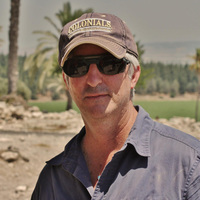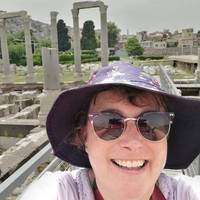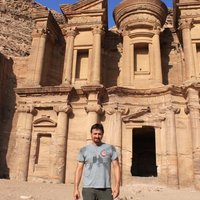
Alexandra Oliveira
Member of the Hellenic Institute of Egyptology
PhD. Student
History and Culture of the Religions
Dissertation: Baal the many faces of a 'Lord': anatomy of a divinity.
Masters in Ancient History
Thesis: The reception of Baal in pharaonic Egypt. Metaphors and Syncretisms.
Tutor in Universidade Aberta de Lisboa:
History of pre-classical civilizations
History of classical civilizations
Supervisors: Prof. Dr. José Augusto Ramos and Prof. Dr. José das Candeias Sales
PhD. Student
History and Culture of the Religions
Dissertation: Baal the many faces of a 'Lord': anatomy of a divinity.
Masters in Ancient History
Thesis: The reception of Baal in pharaonic Egypt. Metaphors and Syncretisms.
Tutor in Universidade Aberta de Lisboa:
History of pre-classical civilizations
History of classical civilizations
Supervisors: Prof. Dr. José Augusto Ramos and Prof. Dr. José das Candeias Sales
less
Related Authors
Paul Bowman
Cardiff University
John Huehnergard
The University of Texas at Austin
Eric H Cline
The George Washington University
Alejandra B Osorio
Wellesley College
Ayelet Zohar
Tel Aviv University
David Seamon
Kansas State University
Jo Shoebridge
Independent Researcher
Maria Nilsson
Lund University
Enrico Cirelli
Università di Bologna
Florin Curta
University of Florida
InterestsView All (29)










Uploads
Papers by Alexandra Oliveira
The so called “rebirth” or “rising” of these divinities is never clearly expressed in the mythological narrative but implicit in the underlying development of ritual dynamics, causing antagonistic scholar positions as to their labelling as divinities that resurrect from death.
In this paper, we are going to examine the woman asceticism in Egypt and
mainly the person of Mary of Egypt. One of the most remarkable phenomena
in the early history of Christianity was the growth and spread of the Egyptian
anchoretic and monastic movement. The details of the rise and development
of female asceticism in Egypt remain a matter of debate. Generally,
monasticism in Egypt was an overview of the legacy of the men and women
in Egypt who chose to practice the search for God by separating themselves
from the accepted obligations of life in a Late Antique city or village, where
the individual was firmly integrated into the family and the citizen body. We
know many things about the asceticism of Christian men in Egypt, but very
few things are known about the women as nuns, as desert ascetics in Egypt.
Of course, for these ascetic women the ultimate aim of bodily and spiritual
perfection, the Aim of true virginity and its highest reward, was the final
union with Jesus Christ, the bridegroom in the spiritual marriage. The desert
was not the place of predilection and the space that Christian women of the
early centuries chose to live for God. A lot of them chose their own homes,
bringing with them daughters and relatives to form a community of prayer.
Mary of Egypt is the example of the fallen state of sexual sin and the grace of
repentance. The edification itself in the life begins with the episode in which
Mary the harlot tells about her attempt to enter along with the faithful into the
church for the services to the Exaltation of the Lord’s Cross. She lived 47 years
in the desert in austere penance. The story of Mary before her conversion to
God is particularly realistic; it contains all the details of her life of fornication
in her youth.
Talks by Alexandra Oliveira
Article Reviews by Alexandra Oliveira
The so called “rebirth” or “rising” of these divinities is never clearly expressed in the mythological narrative but implicit in the underlying development of ritual dynamics, causing antagonistic scholar positions as to their labelling as divinities that resurrect from death.
In this paper, we are going to examine the woman asceticism in Egypt and
mainly the person of Mary of Egypt. One of the most remarkable phenomena
in the early history of Christianity was the growth and spread of the Egyptian
anchoretic and monastic movement. The details of the rise and development
of female asceticism in Egypt remain a matter of debate. Generally,
monasticism in Egypt was an overview of the legacy of the men and women
in Egypt who chose to practice the search for God by separating themselves
from the accepted obligations of life in a Late Antique city or village, where
the individual was firmly integrated into the family and the citizen body. We
know many things about the asceticism of Christian men in Egypt, but very
few things are known about the women as nuns, as desert ascetics in Egypt.
Of course, for these ascetic women the ultimate aim of bodily and spiritual
perfection, the Aim of true virginity and its highest reward, was the final
union with Jesus Christ, the bridegroom in the spiritual marriage. The desert
was not the place of predilection and the space that Christian women of the
early centuries chose to live for God. A lot of them chose their own homes,
bringing with them daughters and relatives to form a community of prayer.
Mary of Egypt is the example of the fallen state of sexual sin and the grace of
repentance. The edification itself in the life begins with the episode in which
Mary the harlot tells about her attempt to enter along with the faithful into the
church for the services to the Exaltation of the Lord’s Cross. She lived 47 years
in the desert in austere penance. The story of Mary before her conversion to
God is particularly realistic; it contains all the details of her life of fornication
in her youth.